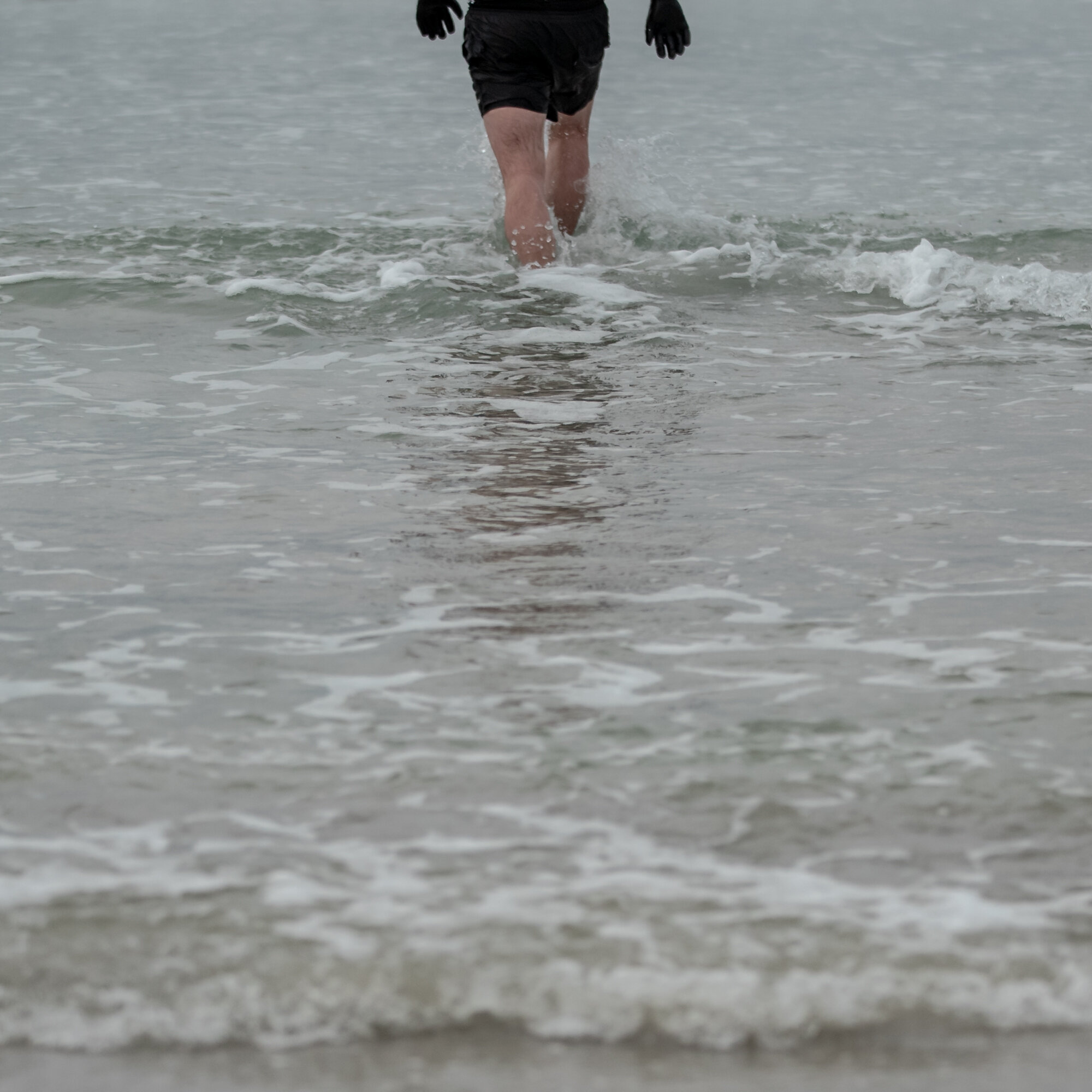9 Things I’ve Discovered Wild Swimming In Cold Water Conditions
A year ago, I started wild swimming in the cold waters off the small Scottish island of Tiree. The stunning white beaches and crystal-clear turquoise waters drew me in from the moment I moved here. However, for the majority of my swimming life, like many other swimmers, I spent my time training in 25m and 50m swimming pools. Over the past year I’ve had to relearn some basics so that I can enjoy and enhance my experiences wild swimming in cold water conditions. Here’s the 9 things I’ve discovered which made all the difference.
Acclimatise To The Cold Water
Protect Your Extremities
Great Company
Take Your Time
Get Ahead Get A Hat
Understand And Listen To Your Body
Wrap Up
Hot Drink
Earplugs
My biggest discovery: Acclimatising
I acclimatise to my local cold water swimming conditions. This has been my most important learning. The result: I can now wild swim in the cold water conditions for over 45 minutes in the depths of a Scottish winter without a wetsuit.
How? I approached it in 3 steps. I started off heading into the water once a week on the same day every week regardless of the water temperature over a 4-week period. In the next four week block I increased getting into my local cold water conditions to twice a week. And finally, three times a week for the last four week block. The duration of time in the water was not important at that stage, it was more about knowing how my body felt in the cold water and listening to it.
I found it important to remember when wild swimming in cold water there’s a lot going on in my brain and throughout my body. It was that cacophony of stimulations outside of the norm which hits the moment I step into the water. The first thing I experience, cold water shock response.
“Clinical hypothermia takes place at a core body temperature of 35°C”
It’s worth remembering that there is a small temperature gap between a normal functioning body and clinical hypothermia. I’ve been told and subsequently read that my body’s normal core temperature moves between 36.5°C and 37.5°C degrees Celsius, and clinical hypothermia takes place at a core body temperature of 35°C. So, it’s not a massive drop. The reason I mention this stuff is that the body reacts in so many different ways in these conditions. I know I experienced numbness, pain and very erratic breathing the first time I went ‘sans’ wetsuit.
Discovery 2. Protect your extremities
I found that wearing a good pair of Neoprene surfing boots or socks and gloves shifted my entire experience to a much more positive and enjoyable one. The experience of swimming in cold conditions was like night and day as soon as I protected my extremities. For me it was the perfect compromise. A compromise which enabled me to spend exponentially more time in cold water conditions.
“let the various feelings wash over me and level out, in fact, there is a level of excitement”
I do still experience cold water shock when I first enter the water. Involuntary sharp and uncontrollable intakes of breath that feel like a shortness of breath. However, I know they are coming and because my extremities are fine, I can focus on calming things down and keeping my head above the water so as not to put myself in danger. I now know what to expect and to let the various feelings wash over me and level out. In fact, there is a level of excitement in the whole experience, waiting for that moment when, without warning, everything changes. That moment when a warmth consumes you. Nature’s version of a sip a great Whiskey.
Discovery 3. Great Company
If you’ve ever spent time in a public swimming pool, you’ll know that there are always lifeguards looking out for you. If you’ve been to a beach in the summer, in most cases, you’ll find lifeguards on the beach looking out for you. If you’re wild swimming in cold water condition for the most part, there isn’t anyone being paid to look out for you.
“I can’t stress enough how important it is to always wild swim with others.”
I can’t stress enough how important it is to always wild swim with others. That’s not just for your benefit but theirs as well. And, if there is no one crazy enough to experience the awesomeness of wild swimming in cold water conditions with you, then find someone who is happy to watch from the side and who has access to some way of getting help if the worst should happen. It is swimming prefaced with “wild” for a reason.
Discovery 4. Take your time
For me wild swimming in cold water conditions is all about leaving daily life and timeframes behind. In my mind there is no reason to rush anything and that includes getting into the water. I’ve found through experience just going for it does not work for me. I always spend a few moments just thinking about the wild swim ahead. It’s just a time to think about the first few minutes it takes to get from the water’s edge to waist height. I’ve read many different views how best to submerge.
“All the time focusing on the unstoppable cold water shock.”
But, once I’m waist height I take a few moments to get my mind in the right place and then squat down let the water cover me to halfway up my neck and then gently push off and do a few breaststroke movements. All the time focusing on the unstoppable cold water shock. And then that point of equilibrium kicks in and everything in my world is great.
Discovery 5. Get Ahead Get A Hat
You may have read of my other post in which I talk about the journey I went through to find a hat the really worked for me when wild swimming in cold water. I think the choice you make must be a very personal one. But choose you must. Without a hat I’ve found that I just can’t shake the ice cream head and certainly can’t really enjoy the experience of wild swimming. However, that’s not because of the common myth that our heads are where most of our heat is lost. In a 2008 article by the guardian they highlight that:
“Rachel Vreeman and Aaron Carroll, at the centre for health policy at Indiana University in Indianapolis, rubbish the claim in the British Medical Journal. If this were true, they say, humans would be just as cold if they went without a hat as if they went without trousers. "Patently, this is just not the case,"
But, add water to the mix and say hello to brain freeze. Now add a hat of your choosing and say hello toastie head to match the strangely warm submerged part of your body.
Discovery 6. Understand And Listen To Your Body
One of the things I’ve noticed is wild swimming in cold water conditions amplifies the signals my body sends me to let me know what’s going on internally and externally. I know that if at any point during my swim I start to shiver, this is a bad sign. It means my body is struggling to keep my core temperature at a safe level.
“My body is using the involuntary muscle contractions to generate heat.”
My body is using the involuntary muscle contractions to generate heat. The second this happens I’m out of the water. The thing about us humans is we are all so different and because of this I always remember there is never one rule to fit everyone. I’ve learnt that all that matters to me is listening to my body and act on those signals. As a result, I’ve managed to avoid the big danger signs of mental confusion, slurred speech, poor coordination or an inability to move in a controlled way.
Discovery 7. Wrap Up
I have to say that another must-have for me, both before and after my wild swim in cold water, is a Dryrobe. Wow what a discovery. I’m sure there are other brands out on the market but as with my wool hat, my Dryrobe serves to help me go through the after-swim slow warming process with the minimum of fuss. Because I only swim in shorts I get into my Dryrobe, hop in the car and warm up. I don’t go through the stress of trying to dry myself in the cold and getting into clothes that just don’t want to play ball. I can save all that for home and a warm house.
Did you know once you get out of the water you can continue to keep cooling for 20-30 minutes? Which could cause all manner of issues if you don’t start to warm yourself as soon as you get out of the water.
Discovery 8. Hot Drink
As I progressed through my wild swimming journey, I’ve become more organised. I’m now at a stage where I always take a warm drink in flask, even if I don’t drink it. It’s sort of reassuring to have it there. And, although I don’t change into clothes and live in my Dryrobe, I take a complete set of dry clothes. In the past year I’ve never used any of those items, but you can be sure the day I don’t is the day I’ll need them.
Discovery 9. Earplugs
Ear plugs are a new thing for me. During the summer of 2019 the windsurfers and surfers on the island warned me about something called Surfer’s Ear. Although it’s called surfer’s ear it can impact anyone who spends regular time in cold water and wind. The combination of wind and cold water creates a chill factor. In short, my understanding of the problem is; bone in your ear canal closes up over time – due to the chill from cold wind and water - which in turn traps water within the ear, creating conditions that can lead to infection in the ear. That’s my very basic explanation and understanding. After some research it turns out there are a bunch of earplugs on market that are designed to help reduce the long-term problem. I can’t really tell you too much because I’ve only just started using ear plugs. What I can say is I’ve noticed a marked difference in comfort during and after wild swimming in cold conditions, so they are now a permanent item in my cold water kit bag.
Conclusion
I take my time to acclimatise to local cold water swimming conditions. I found that wearing Neoprene surfing boots and gloves shifted my entire wild swimming experience in cold water to a much more positive and enjoyable one. It is swimming prefaced with “wild” for a reason, I can’t stress enough how important it is to always wild swim with others. I always spend a few moments just thinking about the wild swim ahead before getting in. I’ve found through experience just going for it does not work for me. Thinking does not stop at getting into the water. Listening to my body and acting on the things it’s telling me is so important. And I don’t stop listening when I’m out of the water either. I warm up, hot drink and dry clothes on stand-by. Finally, earplugs are a new addition to my cold water swimming kit to avoid ear infection. All these discoveries have made Wild Swimming in Cold Water Conditions a hugely enjoyable experience and a valuable part of my life, with benefits that last far beyond my time in the water.









